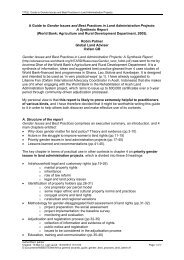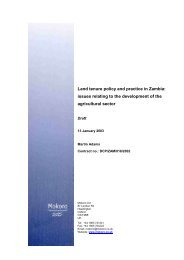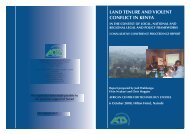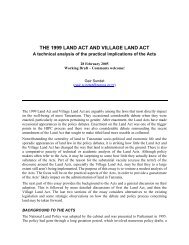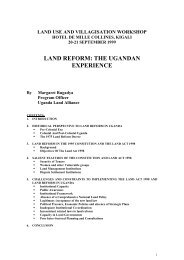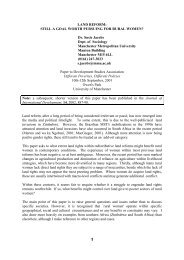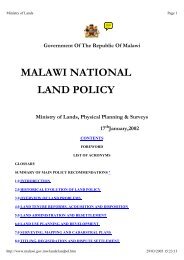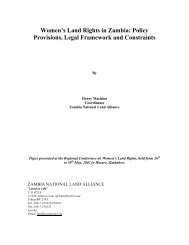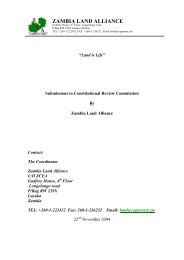Download - Mokoro
Download - Mokoro
Download - Mokoro
- No tags were found...
Create successful ePaper yourself
Turn your PDF publications into a flip-book with our unique Google optimized e-Paper software.
22contiguous, and then subdivided these either into medium-sized farms or intosmallholdings, making possible the provision of common grazing land and the provisionof required infrastructure.The availability of small parcels of land is crucial not only at an initial stage ofredistribution, but also subsequently, to enable those who wish and are able to moveinto new types or larger scales of production to extend (van den Brink et al 2006:30). Todetermine availability of smaller properties, LRAD proposed that “local governments andmunicipalities should be requested to provide an audit of agricultural smallholdingswithin their boundaries” (MALA 2001:13). However, this one mechanism to determinethe availability of smaller agricultural properties – the Municipal Land Audit – has notbeen conducted.This attachment to ‘viable farm size’ has been challenge by evidence of an inverse sizeproductivityrelationship in certain situations (Binswanger et al 1995). However, whetheror not small farms are more efficient than large ones is contingent on what is beingproduced, using what technology and for which markets. The key argument in favour ofsubdivision in the international literature is that, given that there are few intrinsiceconomies of scale in primary production and that, other things being equal, smallerlandholdings in which there is no hired labour are more efficient than large farms(Binswanger et al 1995). Where economies of scale in primary production do exist, theyare largely due to the need for lumpy inputs like machinery (eg. combine harvesters) andthe costs of compliance with private and public regulation – again, areas wherecooperation among smallholders, with support from government or the private sector,can overcome barriers for smallholders. In addition, subdivision is a precondition forintensifying land use in countries with a highly skewed distribution of land ownership,such as South Africa, where underutilisation of agricultural land is considered to besubstantial.However, the absence of a strategy to promote subdivision has led to a great irony inland reform. While applicants are given little choice but to buy whole farms intact withoutdividing these into smaller units more suited to their needs because only large farms are‘viable’, agricultural properties are being subdivided for the purposes of luxury countryliving for the wealthy who wish to live in an agricultural setting but may have no intentionof farming – so-called “lifestyle farming”. So poor people accessing land are required toadapt their lives to the demands that the land must be farmed, and farmed at scale, in amanner that is both capital-intensive and risky while, for the rich, changes have beenallowed in land use and farm sizes.While LRAD offers the ‘flexibility’ of grant size, there is no equivalent flexibility in landsizes. There is thus a mismatch between policy mechanisms emphasizing entry at avariety of levels (ranging from food safety net projects to small and medium sized farms)and the actual array of properties available to would-be beneficiaries. In land reform, a‘small project’ means ‘little money’ and therefore usually not enough to buy any farmsbeing offered for sale. Unless there are interventions to facilitate the subdivision ofagricultural land, the sizes of existing land parcels could drive a continued pattern oflarge group projects – one problem from the first phase of redistribution that LRAD wasintended to address but has tended to perpetuate. LRAD was based on “the ability ofparticipants to sub-divide existing large land units” (MALA 2001), yet a review of theLand Redistribution for Agricultural Development (LRAD) programme recognises thatPolicy Options for Land and Agrarian ReformProgramme for Land and Agrarian Studies, University of the Western Cape




